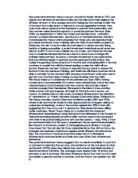The parental investment theory was put forward by Robert Trivers in 1972, and argues that differences between males and females have their origins in the different amount of time, energy and effort being put into having a child. We often hear that males seem to behave in a more aggressive manner, they care more about physical attractiveness in a partner than personality, and that women value financial capacity of potential partners the most (Buss, 1989). An explanation of this is that males and females have a different amount of parental investment, and the root of the behaviour is in Darwin’s natural selection theory which proposes that those who are reproductively successful and leave more offspring will have their characteristics passed on. Therefore, the aim for both males and females is to create as many living, healthy offspring as possible. A male’s investment is relatively small, as he has almost no limit to how many children he can make, and therefore the best way to maximise his reproductive success is to have many matings with multiple fertile partners. However, a female’s investment is very substantial. She has a limited supply of gamete and her reproductive life is short, she carries the growing foetus around for 9 months and after giving birth, she must continue to nourish the child by breastfeeding, or else the child will not survive. Therefore, her best chance of reproductive success is to ensure the survival of her few precious offspring, and therefore will need a partner who is able to provide for her and her child, showing commitment when she cannot get her own food because of being too busy looking after the child.

This is a preview of the whole essay
Peer Reviews
Here's what a star student thought of this essay
Quality of writing
Spelling and grammar are consistently high throughout, with correct terminology used when necessary (e.g. reductionist, investment, sexual jealousy). The writer also uses a number of different joining sentence constructions in order to make the essay easy to read, and avoids repetition, good examples include: therefore, however, this suggests, it must be mentioned, a major flaw, an extension, it seems that.
Level of analysis
As mentioned, the level of analysis is typically very strong – for example, the writer not only gives information on the theory of parental investment, but then uses existing studies to back-up the theory (e.g. Buss (1989), having conducted a commendable 33-country cross-cultural study found that men valued physical attractiveness more than women did and also valued women younger than themselves), what is also brilliant about this is example is the level of detailed provided about the study (name, date, number of countries) clearly indicating that the student knows what they are talking about. Furthermore, the student goes as far as to discuss possible limitations of these studies demonstrating good critical thinking skills (e.g. “It may just have been that the females felt more vulnerable since they did not know the strangers and perhaps would have agreed under different circumstancesâ€Â). Having discussed Trivers’ theory, the writer goes one step further to point out that it does have limitations (impossible to prove, too reductionist) – again showing critical thinking skills – and then uses Buss and Schmitt (1993) Sexual Strategies theory as a potential addition/replacement for Trivers. This demonstrates originality, proves the student has thought about the topic clearly, and has drawn a valid argument – all in all a good example of critical analysis.
Response to question
Although there is no explicit question given, the writer covers the evolutionary explanations of parental investment in some good detail and demonstrates good analysis throughout. The student provides thorough background information on the Parental Investment Theory put forward by Trivers (e.g. “argues that differences between males and females have their origins in the different amount of time, energy and effort being put into having a childâ€Â), and what is encouraging to see is the frequent use of dates to support theories and studies – this is good as it displays detailed knowledge of these concepts, and will prove any further reading that may have been done. The major downfall of this essay is the lack of a clear introduction, although the first couple of sentences introduce the topic, they are immediately followed by a paragraph full of specific details and examples – it is important to have a separate introductory paragraph – even if very short – to set the scene for the reader, highlight the issues to be discussed, and hint at the argument you will be making. On the other hand, the student has written a very nice concluding paragraph which brings together their discussion points, providing the rationale for the decision they reach (“it is likely that the two theories together provide a better explanation than the parental investment theory aloneâ€Â).







